

Managing an NGO. The Matrix Map: A Powerful Tool for Mission-Focused Nonprofits - NPQ - Nonprofit Quarterly. PART ONE: How to Create the Matrix Map It’s easy to embrace the concept of the Dual Bottom Line, but harder to apply it in a real-world board setting.

For example, board members—and many staff—are seldom familiar with all of the programs and activities of the organization. Livework - We design services that impact on businesses and make a difference for their customers. Public sector. Digital Government Digital government service: the fragmented experience Governments around the world face a set of challenges that are highly complex and interconnected: education, health, social security, and transparency to… Read more Government.
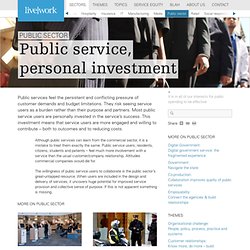
Social responsibility. Behaviour change Making a green experience the best experience Few customers are prepared to suffer to be green.
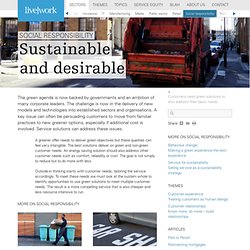
For green businesses to access mainstream markets, the customer experience must equal or… Media; Content providers. Today’s media landscape is challenging to operate in.
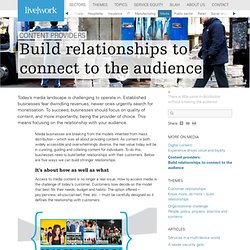
Established businesses fear dwindling revenues, newer ones urgently search for monetisation. To succeed, businesses should focus on quality of content, and more importantly, being the provider of choice. This means focusing on the relationship with your audience. Media businesses are breaking from the models inherited from mass distribution – which was all about providing content. As content is both widely accessible and overwhelmingly diverse, the real value today will be in curating, guiding and collating content for individuals. It's about how as well as what Access to media content is no longer a real issue. Discovery is more than recommendations Discovery is a hot topic now that we can access more content than we can consume. Wow’ moments vs. Building ‘wow’ moments in certain interactions does not automatically result in a ’wow’ experience for customers. Personal identity Not personalised but personal. Facilitate connections. Toward a Nonprofit Theory of Leadership and Organizational Culture.
Nonprofit organizations are different from business and government.
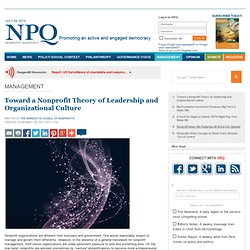
One would reasonably expect to manage and govern them differently. However, in the absence of a general framework for nonprofit management, third sector organizations are under persistent pressure to look like something else. On the one hand, nonprofits are advised (sometimes by “venture” philanthropists) to become more entrepreneurial and business savvy, orienting their organizations more closely to market forces. At the same time, organizations are urged to make increasing the reliability and accountability of their “outcomes” their highest priority, by controlling internal processes and structuring and orienting themselves as hierarchies. The following statements on Leadership and Organizational Culture are excerpted from Principles & Practices for Nonprofit Excellence, a 40-page document available free at MCN’s web site.
Communities-count-final-report. R-14-02. Mckinsey-Full Article. Grantmakers for Effective Organizations (GEO) The Economic Approach to Social Capital. NBER Working Paper No. 7728Issued in June 2000NBER Program(s): LE LS To identify the determinants of social capital formation, it is necessary to understand the social capital investment decision of individuals.
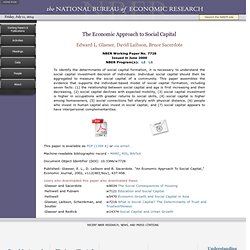
Individual social capital should then be aggregated to measure the social capital of a community. Sprawl and Urban Growth. NBER Working Paper No. 9733Issued in May 2003NBER Program(s): LE PE EEE Cities can be thought of as the absence of physical space between people and firms.
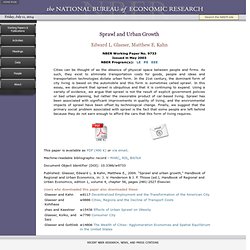
As such, they exist to eliminate transportation costs for goods, people and ideas and transportation technologies dictate urban form. In the 21st century, the dominant form of city living is based on the automobile and this form is sometimes called sprawl. In this essay, we document that sprawl is ubiquitous and that it is continuing to expand.
Using a variety of evidence, we argue that sprawl is not the result of explicit government policies or bad urban planning, but rather the inexorable product of car-based living. w8117. CIVICUS World Alliance for Citizen Participation. Government of Ontario - ONe-Source for Business. Mass collaboration: How we can transform the impact of public funding. In this provocative and practical paper, social entrepreneurship leader Matthew Pike sets out a course of action for a wholesale change of culture, decision-making and accountability in the contracting of public services, to take advantage of a 'rare window of opportunity to transform how government works with others'.
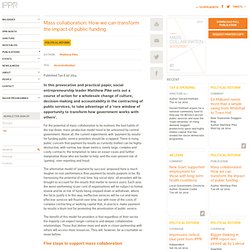
For the potential of mass collaboration to be realised, the bad habits of the top-down, mass-production model need to be unlearned by central government. Above all, the current experiments with ‘payment by results’ for funding public service providers should be scrapped. There is rising public concern that payment by results as currently trialled can be highly destructive, with narrow, top-down metrics; overly large, complex and costly contracts; the temptation to take on easier cases and further marginalise those who are harder to help; and the ever-present risk of ‘gaming’, over-reporting and fraud.
Impact_Investing_slides. Burgh Diaspora - Pacific Standard. Follow us Burgh Diaspora Recent articles Silicon Valley Is Detroit: Are Zoning Laws to Blame?
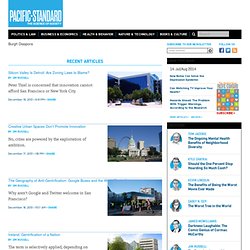
By Jim Russell. What is a social enterprise? - Learn about your enterprise - Social Enterprise Canada. What do we really mean when we discuss social enterprise?
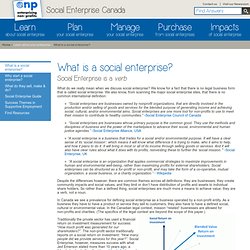
We know for a fact that there is no legal business form that is called social enterprise. We also know, from scanning the major social enterprise sites, that there is no common international definition: » “Social enterprises are businesses owned by nonprofit organizations, that are directly involved in the production and/or selling of goods and services for the blended purpose of generating income and achieving social, cultural, and/or environmental aims.